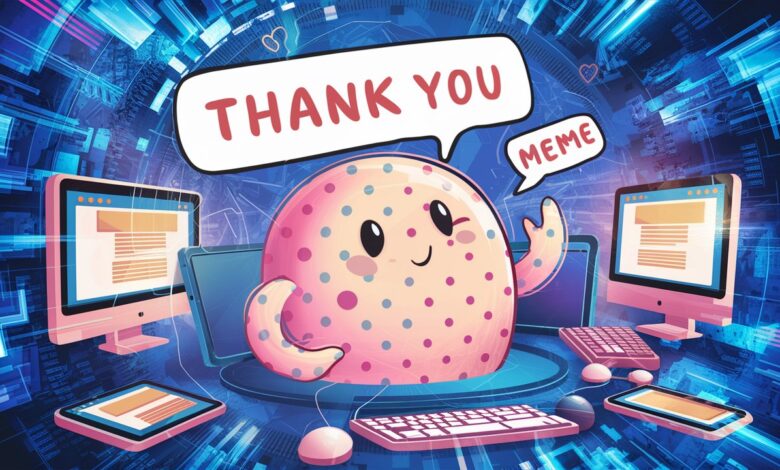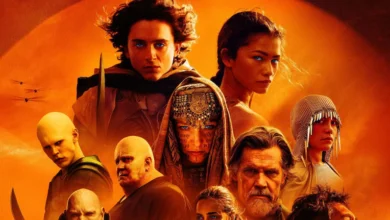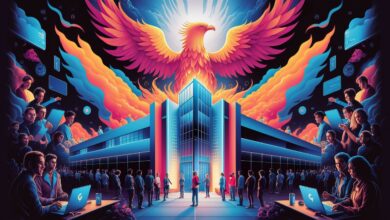The Rise of the “Thank You Meme”: How Gratitude Went Viral in the Digital Playground

Introduction
In the bustling, often chaotic landscape of internet culture, where sarcasm and snark frequently dominate, a surprisingly wholesome trend has carved out a permanent niche: the “Thank You Meme.” These digital expressions of gratitude—wrapped in humor, absurdity, and hyper-relatable imagery—have transformed simple appreciation into a shared linguistic currency. Far from a fleeting trend, thank you memes represent a cultural shift in how we communicate emotion online. They bridge sincerity and comedy, allowing users to convey heartfelt thanks without the perceived awkwardness of earnestness, all while leveraging the universal language of pop culture references. From reaction GIFs of celebrities bowing dramatically to crudely edited images of animals “handing” virtual bouquets, these memes have become the go-to for acknowledging kindness, favors, or even mundane acts of decency in our hyper-connected, yet often detached, digital age. This article explores the anatomy, appeal, and enduring impact of this phenomenon, revealing why a simple “thank you” became the internet’s favorite inside joke.
What Exactly Defines a “Thank You Meme”?
At its core, a thank you meme is any visual or textual template repurposed to express gratitude in an exaggerated, humorous, or culturally resonant way. Unlike formal thank-you notes, these memes thrive on absurdity and relatability. Common formats include reaction images (e.g., Dwight Schrute from “The Office” offering a shaky handshake), GIFs (a cartoon character bowing repeatedly), or viral templates like the “Distracted Boyfriend” captioned to show loyalty to a benefactor. The humor often stems from juxtaposition—placing earnest gratitude in an overly dramatic, surreal, or self-deprecating context. For instance, pairing a photo of a sobbing toddler with text like, “Me trying to express how much this free coffee meant to me.” This disarms the receiver, making appreciation feel genuine yet unburdened by formality. The meme’s power lies in its flexibility: it can be self-made using tools like Imgflip or Canva, or reshared from established viral libraries, adapting to contexts as trivial as thanking a friend for a meme repost or as significant as acknowledging community support during crises.
The Evolutionary Arc of Gratitude in Online Spaces
The evolution of gratitude online mirrors broader shifts in digital communication—from text-heavy sincerity to visual, bite-sized emotional shorthand. Early internet forums relied on typed “TY” or earnest paragraphs, but as platforms like Tumblr, Reddit, and Instagram prioritized visuals, gratitude evolved into something more shareable and communal. The thank you meme emerged as a natural response to this, democratizing appreciation by making it accessible, replicable, and less intimidating. Crucially, it also reflects societal fatigue with performative positivity; memes allow gratitude to feel authentic precisely because they’re self-aware and ironic. They acknowledge the awkwardness of thanking someone directly while still doing it, thus resonating deeply in cultures where vulnerability is often masked by humor. This evolution highlights a paradox: the more detached our interactions become, the more we crave these micro-moments of connection, packaged in a format that feels native to the speed and absurdity of online life.
Why Thank You Memes Strike Such a Universal Chord
The resonance of thank you memes is rooted in three psychological pillars: relatability, emotional safety, and cultural fluency. First, they tap into shared experiences—overwhelming gratitude for small acts, social anxiety around expressing thanks, or the dread of emotional heaviness. By framing these feelings in meme language, they normalize them, creating instant camaraderie. Second, memes provide emotional safety. Using a popular template (like Keanu Reeves looking humbled) lets the sender convey depth without personal exposure, reducing the risk of rejection or awkwardness. Third, they leverage cultural fluency: referencing SpongeBob, vintage cartoons, or viral moments acts as a social handshake, signaling membership in an internet-savvy tribe. This fluency transforms gratitude from a transactional exchange into a collaborative joke, strengthening bonds. Importantly, in an era of digital burnout, the brevity and humor of these memes offer emotional relief. They’re gratitude without the emotional labor, making them ideal for generations raised on rapid-fire, low-stakes interactions.
Iconic Formats and Viral Examples That Defined the Genre
Several meme formats have become synonymous with digital gratitude, each with distinct traits. The “Over-the-Top Reaction” style—exemplified by GIFs of celebrities like Jennifer Lawrence fake-sobbing at awards shows—uses hyperbole to humorously amplify appreciation. Another staple is the “Humble Offering” template, where characters like Sweaty Guy in a Suit (Succession’s Greg) present a mundane item as a grand gesture, captioning it, “My humble thanks for your wisdom.” Animal memes also dominate: think “Crying Cat” with text like, “When you cover my shift… thank u, I owe u my 9 lives.” Animated GIFs of bowing anime characters or Meryl Streep clapping slowly add cinematic flair to minor acknowledgments. The “Deep Fried” aesthetic—low-quality, overly saturated images—is often used for ironic thanks, mocking the formality of gratitude itself. These formats succeed because they’re templates: users insert personal context while relying on collective recognition. For example, the “This You?” meme was repurposed for thanks, showing a benefactor’s past kindness contrasted with their latest favor, captioning it, “Proof you’re a legend. Thank you.”
Crafting Your Own Thank You Meme: A Creator’s Toolkit
Creating an effective thank you meme hinges on balancing originality with familiarity. Start by selecting a culturally relevant template—sites like Giphy, Know Your Meme, or Imgur offer vast libraries. Tools like Kapwing or Meme Generator allow drag-and-drop editing. The text should be concise: lead with humor (“When you lend me $5 like it’s a million”), then anchor it in sincerity (“…but seriously, you saved me”). Context is key: a meme thanking a coworker might use Michael Scott from “The Office” for lightheartedness, while gratitude for emotional support might use Frodo thanking Sam in Lord of the Rings. Audience awareness matters too—niche references (e.g., gaming or anime memes) deepen connection if shared within specific communities. Avoid overused formats unless subverting them (e.g., “Woman Yelling at Cat” reinterpreted as “Me trying to thank you vs. my social anxiety”). Finally, timing enhances impact; deploy memes promptly after the act you’re acknowledging to maximize relatability. Remember, the goal isn’t artistry—it’s authenticity wrapped in shared laughter.
The Broader Impact on Digital Communication and Culture
Beyond laughs, thank you memes exert a profound influence on digital communication. They’ve reshaped social norms, making gratitude more frequent and less burdensome—a counterbalance to online negativity. In communities like Reddit or Discord, they foster reciprocity; a well-timed meme can spark chains of appreciation, strengthening group cohesion. However, critics argue they risk trivializing genuine emotion or enabling emotional laziness. Yet, proponents counter that in fast-paced digital spaces, memes make gratitude possible where silence might prevail. They’ve also infiltrated professional realms; Slack channels use “Thank You Spongebob” GIFs to celebrate team wins, blending professionalism with personality. Culturally, they reflect Gen Z and Millennial values: rejecting rigid formality, embracing irony as sincerity, and using humor as a coping mechanism. Ultimately, these memes democratize emotional expression, proving that in the digital age, even gratitude can go viral—and that’s something worth thanking the internet for.
Conclusion
The thank you meme is more than a passing internet quirk—it’s a microcosm of how digital culture humanizes communication. By marrying gratitude with humor, absurdity, and shared references, it disarms cynicism and fosters connection in an environment often criticized for its impersonality. These memes acknowledge a fundamental truth: even in a world saturated with content, we still crave recognition and appreciation. They allow us to say “thank you” without pretense, transforming a simple act of kindness into a communal inside joke. As online interactions continue to evolve, the thank you meme stands as a testament to the internet’s unexpected ability to cultivate warmth amid the chaos. So next time you reflexively share that “Bowting Shaq” GIF to acknowledge a friend’s help, remember—you’re participating in a vibrant, evolving language of gratitude that’s redefining how we say thanks, one meme at a time.
Frequently Asked Questions (FAQs)
Q: What exactly counts as a “thank you meme”?
A: Any reusable visual template (image, GIF, video clip) or textual format altered to express gratitude humorously or ironically. Common examples include reaction GIFs of celebrities, animals, or fictional characters paired with captions that exaggerate appreciation (“When you remember my birthday… you’re a wizard, Harry”).
Q: Why did thank you memes become so popular?
A: They balance sincerity with low-stakes humor, making gratitude feel accessible and unawkward. Their shareability fosters community, and their reliance on pop culture creates instant relatability in online spaces where traditional expressions can feel too formal or vulnerable.
Q: How can I create a good thank you meme?
A: Start with a recognizable template (e.g., Drake Hotline Bling for tiered thanks). Use free tools like Imgflip or Canva. Keep text short—lead with a joke, then add genuine sentiment. Match the meme’s tone to your relationship (e.g., absurd for friends, subtle sarcasm for coworkers).
Q: Are there downsides to using thank you memes?
A: Overuse can make gratitude feel insincere or lazy. In serious contexts (e.g., condolences), they may seem dismissive. Always consider your audience—avoid obscure references or inappropriate humor in professional settings.
Q: Can I use these memes at work or in formal groups?
A: Yes, cautiously. Stick to widely recognized, mild formats (e.g., “Succession” GIFs for corporate teams). Gauge your workplace culture first—some environments welcome memes for morale, while others prefer direct communication. When in doubt, default to sincerity.



